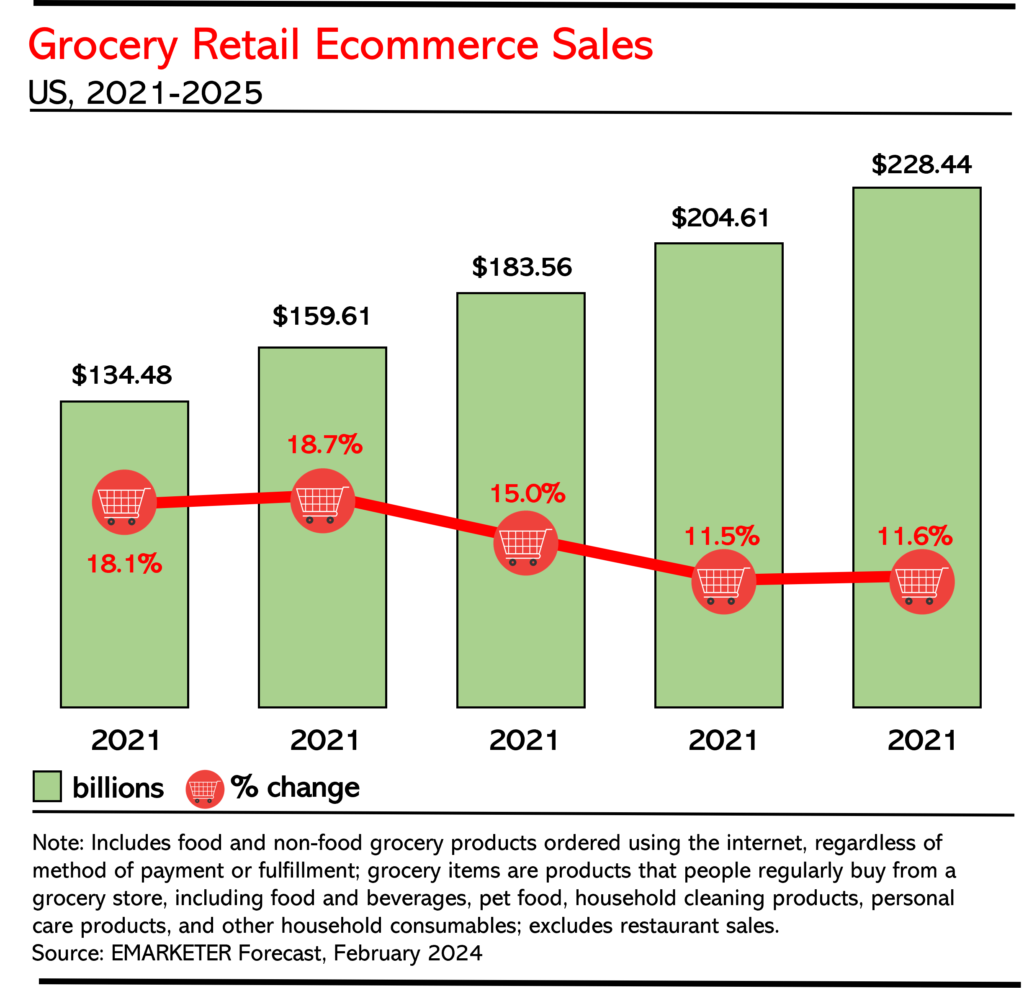As the world emerged from the Covid-19 pandemic, companies wondered whether consumer behaviors adopted during the pandemic would continue. One such behavior was a notable increase in online grocery purchases. In early 2023, journalist Emily Newton wrote, “Stuck at home, increased numbers of consumers turned to their computers or phones to order groceries from websites like Instacart, or food delivery apps such as Uber Eats, DoorDash or GoPuff. With this in mind, a growing cohort of consumers would rather order groceries online for delivery or curbside pickup.”[1] As the pandemic waned, consumers, who were eager to reengage with the world, rediscovered the joys of shopping in person — especially grocery shopping. As a result, the future of online grocery was a bit of a mystery; however, the latest data paints a promising picture.
Online Grocery’s Future
In 2023, as the retail sector became more stable, McKinsey & Company analysts found that the online grocery business did indeed demonstrate it had legs, but challenges remained. They reported, “The rapid migration of consumers to e-commerce channels during the pandemic has plateaued. In May 2023, e-commerce stood at 7.2 percent of all grocery spending, more than 35 percent above pre-pandemic levels. Consumers were initially drawn to online grocery out of necessity, but as they have become more familiar with these channels, their preferences have shifted toward e-commerce.”[2] The biggest reason for shopping online is convenience. McKinsey analysts noted, “Our grocery consumer survey found that convenience — in the form of time savings, delivery, and ease of price comparisons, among others — was the overwhelming draw for online channels.” Unfortunately, inflation hit the grocery sector hard and it affected online grocery purchases. As the McKinsey analysts reported, “In addition to the advantages of online shopping, consumers cited several obstacles, including high delivery fees and a preference for personal contact with products in store. Grocery retailers would likely need to enhance the online experience to boost e-commerce penetration further.”
Despite the challenges, the staff at EMARKETER reports, “Digital grocery will become the largest ecommerce category by 2026, according to our US Digital Grocery 2024 report. To grow their share of digital grocery sales, brands need to understand what motivates consumers to buy groceries online, how the digital grocery experience can be improved, and where growth opportunities lie.”[3] According to the report, online grocery sales will continue to grow, even though the rate of growth will slow (see the following chart).

The EMARKETER staff notes, “Food and beverage is the primary driver of digital grocery gains, but subcategories like pet food, household cleaning products, and personal care products are also contributing to growth, per our US Digital Grocery 2024 report.” The EMARKETER staff also reports that consumers prefer to shop using the grocers’ online platform rather than third party or manufacturer online platforms. The PYMNTS staff reports other studies confirm this trend. They report, “44% of consumers prefer retailers’ websites or apps when shopping for groceries online, while only 29% prefer online marketplaces and 24% prefer brands’ sites or apps, indicating that consumers’ digital loyalty lies with the grocery stores themselves.”[4] Regardless of the platform used, consumers expect a seamless experience. And, thanks to food inflation, customers are looking for bargains.
The EMARKETER staff also reports, “To combat rising shopping costs, 30% of US digital shoppers said they were looking for more discounts and coupons, according to a December 2023 survey from Intelligence Node in partnership with Dynata. But coupons aren’t just important to consumers. Two-thirds (67%) of US consumer packaged goods (CPG) brands expect digital or physical coupons to be a part of retail media network offerings, according to an August 2023 survey from Coresight Research in partnership with NielsenIQ.” In other words, brands and retailers need to collaborate to optimize trade promotions. Artificial intelligence solutions, like the Enterra Trade Promotion Optimization System™ can help optimize trade promotions. The Enterra TPO System is designed to operate as a complementary partner to a client’s existing Trade Promotion Management system’s accounting modules. It adds analysis, optimization, and recommendations to determine the best trade promotion schedules as well as the expected performance they will yield.
EMARKETER isn’t the only group to predict good things are in store for online grocery sales. Journalist Peyton Bigora reports that a study published by Brick Meets Click predicts, “Grocery e-commerce sales [will] increase at a compound annual growth rate of 4.5% over the next five years — more than three times faster than the 1.3% rate forecasted for in-store grocery sales.”[5] The latest news supports those predictions. Journalist Francisco Velasquez reports, “Instacart is getting a big boost from its grocery delivery business — a signal that even in the inflation economy — shoppers are still spending and increasing the number of orders they place on the platform.”[6]
Newton notes, “Online shopping cannot fully replace the human experience of buying groceries in person.” This is because most people prefer selecting their fresh fruits and vegetables themselves. This kind of personalization is difficult to match online. Newton also observes, “Shoppers enjoy personalized experiences. Currently, e-grocery stores do not provide as much personalization as consumers want.” Bagrat Safaryan, CEO of Local Express, believes generative artificial intelligence can help grocers make online shopping more personalized for consumers. He explains, “Personalization is more crucial than ever for grocers to retain loyal customers. It requires complex calculations to analyze customers’ purchase history and preferences based on mobile app, e-commerce and point-of-sale data. In the end, store managers could still get it wrong, as one person’s idea of a perfect product combo could differ from the next.”[7] For the most, Newton notes, purchase data drawn from directly from consumers helps improve personalization. She writes, “Many professionals understand that the average consumer buys the same groceries weekly or monthly. Some new products or different brands may be thrown into the mix, but for the most part, consumers return to their preferred grocery store to buy their favorites. Shoppers enjoy personalized experiences.” Safaryan predicts generative AI will make personalization better than ever for three reasons. They are:
1. Chatbots can help consumers make better (or different) decisions. Although consumers generally buy the same products, they also, from time to time, experiment with new recipes. Safaryan believes chatbots can help them select the items they will need. He explains, “Chatbots can provide personalized product recommendations based on what the customer asks for as opposed to analytical assumptions, improving the overall customer experience and increasing customer loyalty. One of the benefits of the latest generation of AI is that while it doesn’t always know if the result it provides is correct, it can ‘sound’ confident and creative as it recommends products the customer hadn’t thought of with its conversational tone.”
2. GenAI can help with product discovery and upselling. One the opportunities retailers miss when consumers shop in-store is opportunistic buying (i.e., consumers purchasing items that weren’t on their shopping list). Safaryan believes GenAI can capture some of those missed opportunities. He explains, “Generative AI can help customers discover new and related products they may not have otherwise considered. The tool achieves this through various techniques such as visual search, product tagging, and image recognition.”
3. Improved inventory management. Generative AI learns as it works. This means it has usefulness far beyond helping customers find and buy products. For example, the Enterra Autonomous Decision Science™ (ADS®) platform and generative AI powered business applications transform how enterprise optimization, planning, and decision-making are performed. Enterra’s business applications pair industry-specific business knowledge and data, with Enterra’s proprietary math and human-like reasoning engines, to generate insights and recommendations with the subtlety and judgment of a company’s best experts — but at a level of speed and accuracy humans can’t achieve. Enterra’s AI platform pushes the bounds of what’s possible by running countless scenarios to find the combination of actions that maximize business goals most effectively, freeing up employees to attend to other tasks and to support loftier business goals.” Safaryan notes, “For accurate inventory management and insights into customer behavior, grocers must collect the right information and have the data ready. Transaction data is a start, but creating customer profiles based on items purchased and their shopping frequency will enable them to train and personalize their AI tools. … Grocers must think carefully about the impact that generative AI is having on the market. AI tools are only as good as the data that feeds into them, so grocers who prepare today with governed and automated data collection strategies and data cleansing processes are in the best seats for getting ahead.”
Concluding Thoughts
Buying food is a very personal experience for most people. That’s why online grocery shopping is unlikely to surpass instore shopping. Nevertheless, because of its convenience, online grocery sales are predicted to remain strong. Newton concludes, “Almost every aspect of life is affected by technology, and grocery shopping is no exception. More companies in the e-grocery market will emerge, though many major corporations like Walmart and Amazon will continue to lead the pack. Bricks-and-mortar grocery stores must adapt to these changes in consumer sentiment if they want to remain competitive.” I am confident that grocers will adapt and that they will find generative AI to be a big help in years ahead.
Footnotes
[1] Emily Newton, “Why Are E-Grocery Stores Growing in Popularity? Analysis,” European Supermarket Magazine, 3 January 2023.
[2] Bill Aull, Prabh Gill, Dymfke Kuijpers, Nancy Lu, Griffin McLaughlin. and Eric Marohn, “The state of grocery in North America 2023,” McKinsey & Company, 25 September 2023.
[3] Staff, “How brands can grow digital grocery sales in 5 charts,” EMARKETER, 9 April 2024.
[4] Staff, “Retailers Win in Online Grocery,” PYMNTS, 8 March 2024.
[5] Peyton Bigora, “Grocery e-commerce sales predicted to grow 3 times faster than in-store sales, report finds,” Grocery Dive, 25 April 2024.
[6] Francisco Velasquez, “Instacart is getting a big boost from grocery delivery,” Quartz, 7 August 2024.
[7] Bagrat Safaryan, “Three Reasons Generative AI Will Be The Next Disruption For E-Grocery Stores,” Forbes, 10 May 2023.





